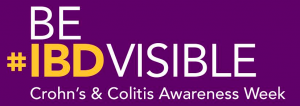
What Is IBD?
The first week of December is Crohn’s and Colitis Awareness Week. These together make up IBD, which is an invisible disease affecting more than three million Americans. Both Crohn’s Disease and Ulcerative Colitis fall under the umbrella of Irritable Bowel Disease (IBD), which is different from the more well known, Irritable Bowel Syndrome (IBS). While both IBD and IBS may cause cramping, bloating, gas, and diarrhea, IBD is distinguished by ulcerations which line the intestinal tract. Ulcerative Colitis affects only the large intestine where the ulcerations are found upon the internal lining of the colon. Crohn’s Disease can affect any part of the digestive tract from tongue to tail. Another distinction is that the ulcerations of Crohn’s Disease can be found on both the inside and outside of the GI tract.
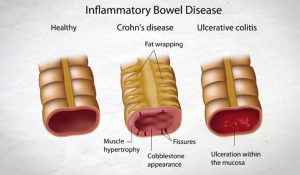
How It Began For Me
Before I was diagnosed with Ulcerative Colitis, I was completely unfamiliar with IBD. It is an invisible disease, after all, and most people don’t talk about it, out of embarrassment. I’m going to try to remove the stigma and share my story in detail. In my case, the first symptom to grab my attention was blood in my stool. I saw my general practitioner first and was told to “eat more fiber.” At that point in my life, I really knew nothing about nutrition, so I increased my consumption of FiberOne bars. The bleeding got worse.
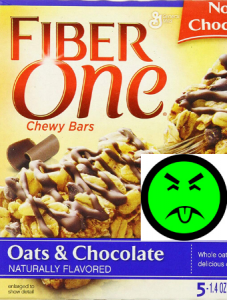
“There’s Nothing Wrong With You.”
In the fall of 2015, I was finally referred to a GI for a colonoscopy. I woke up from anesthesia only to be told, “There’s nothing wrong with you. Have a nice day.” I went home and continued to bleed, mercifully without pain. As the months went by, my symptoms progressed. I found myself feeling “full,” meaning that even after a bowel movement, I was left with the feeling that I still needed to go. That feeling never really went away. It led to a lot of trying, a lot of straining, and a lot of frustration.
Finally, An Answer!
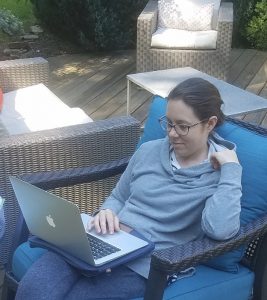
I began researching online. When I researched this newest symptom, I stumbled across the word “Tenesmus.” Tenesmus refers to cramping rectal pain that makes you feel like you need to have a bowel movement even if you’ve already had one. Finally, an answer! From there, I was able to tie Tenesmus and rectal bleeding to Ulcerative Colitis. I went back to my GI and asked for another colonoscopy, just five months after my first. I told him that he must have missed something. All of my symptoms could not be nothing.
In the spring of 2016, I had my second colonoscopy. That time I woke up to the words, “You were right. It’s Ulcerative Colitis.” While I really didn’t want to add another autoimmune disease to my belt, I was relieved to have a diagnosis. The symptoms weren’t all in my head after all. And unlike the words of my ignorant general physician, I had not “been pregnant too much.” I thought that with a clear diagnosis, I would be able to treat the problem well. And for a little while, that was true.
I Thought My Diagnosis Was “No Big Deal”
My GI started me on a rectal Mesalamine suppository. Mesalamine is a first line drug for Ulcerative Colitis and Crohn’s. Because my disease was in the last few centimeters of my rectum, it made sense to get the medication in from that end. It would be more effective than trying to route it there orally. The suppositories worked. My inflammation went away. No more bleeding. No more Tenesmus. In my naivé state, I figured that Ulcerative Colitis would be “no big deal” for me. Sure, I had read about people with agonizing diarrhea and people so sick that their colons were removed and replaced with a j pouch or ostomy bag. But surely, that would not be me. Surely.

Enter C Diff
Fast forward to the spring of 2017. Two weeks after finishing a course of antibiotics for a sinus infection (antibiotics that I likely didn’t need), I began having diarrhea thirty plus times a day. Suddenly my invisible disease wasn’t so invisible. This went on for more than three weeks. The cramping and pain were debilitating. I could not leave the house because I was tied to the toilet day and night. While my GI was running expensive MRI’s and other imaging to check for Crohn’s Disease, he missed a simple stool test, which should have happened first. When he finally did a stool test to check for C Diff, it was positive. I had suffered for weeks unnecessarily.
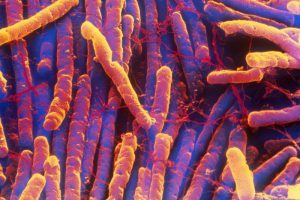
C Diff is a potentially life threatening infection of the colon. Nearly everyone carries some Colostridium Dificile bacteria in their colon. When that bacteria becomes more prevalent than the good bacteria, a problem arrises. In my case, the antibiotic that I took killed all of my good bacteria, leaving the C Diff to grow unchecked in massive quantities. Ironically, it is a specialized, gut-specific antibiotic that works to calm things down. After one round of Vancomycin, I was back to normal. Or so I thought.
When Things Got Worse
All through that summer and into the fall, I had a growing sense of unease. My brain fog was thick. My fatigue was so intense that I struggled to keep up with daily routines. Looking back, we know that I was in the midst of a toxic exposure. We know that my impaired detox pathways led to an accumulation of mycotoxins in my body. These mycotoxins were ramping up inflammation in my colon. Looking back, we know that my microbiome needed attention. While C Diff was not raging, it was still there, waiting silently for the right opportunity to express itself again.

In March of 2018, I took a prescribed anti-fungal (Fluconazole) for a suspected yeast issue. Within ten days, I was hospitalized for an Ulcerative Colitis flare unlike anything I had ever experienced. It began with diarrhea. We ran a C Diff test immediately. It was negative. At home, I tightened up my diet. I tried slippery elm tea. I remember sitting on my kitchen floor, trying to spoon that mucous-like substance into my mouth and failing, because I could not tolerate anything in my stomach at all. Defeated, I knew at that point, I was beyond self care. By the time I was admitted to the hospital, I was passing only blood, in great pain, about forty times a day.
From Then To Now
I was hospitalized for twelve days, unable to eat, unable to care for myself. That flare was only resolved by the use of high dose intravenous steroids. I have been on Prednisone ever since. From 40 mg, I tapered down. Last spring, I was nearly off the Prednisone. I had made it down to 2.5 mg when the C Diff came back. At that point, I had to go back on Vancomycin for the C Diff and raise the Prednisone to 40 mg because the infection inflamed the colitis that had begun to heal.
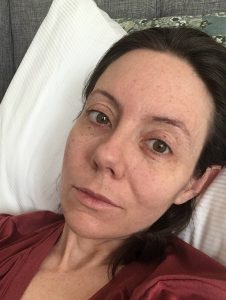
Just this fall, I once again found myself down to 3.5 mg when I flared again. So much for Ulcerative Colitis being “no big deal” for me. Since that hospitalization of 2018, my flares are now marked by pain worse than childbirth. I lose the ability to eat entirely. I quickly deteriorate into a complete invalid who exists only on the bed, the toilet, or rolling on the bathroom floor in agony. My poor husband has dealt with so much between caring for me, taking care of our son, running the house, and working at the same time. (That is worthy of an entire post itself.)
A New Plan for Healing
This time around, I am connected to a new team of doctors and specialists. I am working with an Integrative GI in Houston, who sees me by video. He is so far above and beyond any GI I have ever worked with. I also see a Functional Nutritionist from California who has already directed me down new paths for healing. I’ve moved on from Mesalamine suppositories to Mesalmine enemas, which are much more effective for my current state of disease. I also take an oral Mesalamine, though I have no evidence that it does anything. For now, though, we’re sticking with it.

As of this writing, I’m at 17 mg Prednisone. My team is working with my microbiome this time, not ignoring it. I am on high doses of spore based probiotics and S Boulardii. The goal is to keep the C Diff at bay permanently. After reading my recent Hair Mineral Test, as well as my Organic Acids Test, we are also working to correct my nutritional deficiencies, optimize my digestion, and support my methylation and detox pathways. My Functional Nutritionist has also brought up my need to deal with the psychological trauma and PTSD of being deathly ill again and again on repeat.

(At my worst…the face of invisible disease.)
Understanding Invisible Disease
I’ve written all this in detail to give an honest picture of IBD. This disease is truly invisible. Even at my worst, other than being underweight, I look normal. People have no understanding of the pain, the fear, and the life-altering changes that happen behind closed doors. Even now, on 17 mg of Prednisone, I have to watch everything that goes into my mouth. I have to keep track of how it affects my digestion, my transit time, my bloating, my pain, and my fatigue. Each bite is an experiment, every day. And what was fine last week may not be fine now. I often joke with my husband that no one examines the contents of their toilet like someone with IBD.
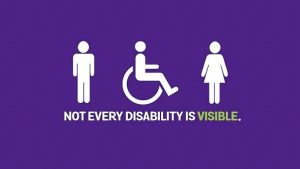
This Crohn’s and Colitis Awareness Week, I hope that you will consider those who live with this invisible disease. Show some grace to the person who cuts in line at the public restroom. Save that huff and gruff when you see a “normal” person park in a handicap spot at the store. Pray for those who live with this horror, both those you know and those you don’t. And if you’re someone who experiences odd, unexplained GI symptoms, push for answers. Be your own advocate. Educate yourself. Find a team of specialists who will work for you and with you. Don’t let IBD win. Be a fighter. Be visible.



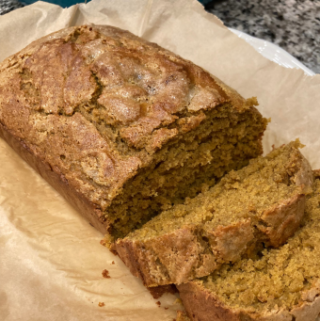
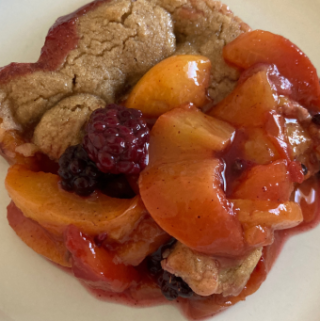

Leave a Reply
You must be logged in to post a comment.